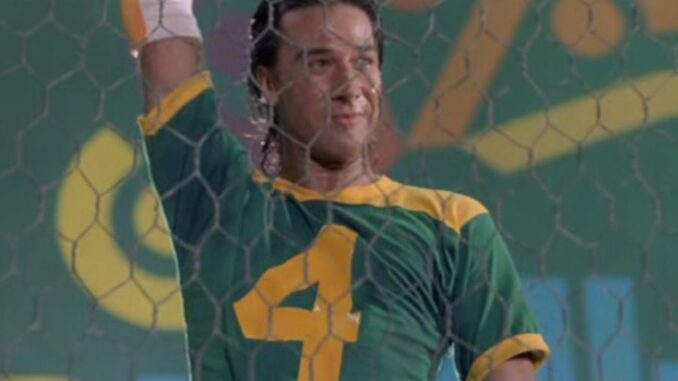
The opening sequence to the ‘80s narcotics interdiction/buddy crime-noir drama Miami Vice featured some incredible guitar riffs, sweet bongo drum reverberations, flashy splashy neon-bathed images of Miami that made us want to hang out at South Beach, and certainly what must be the world record for the briefest introduction to the sport of jai alai ever displayed on network television.
Rumor has it there’s a potential “reboot” of Miami Vice in the works involving Vin Diesel and Fast & Furious screenwriter Chris Morgan. We really liked Fast & Furious to the degree we tried to emulate it by hanging out with super attractive pseudo-criminals and various local street racing gangs but given we didn’t know anyone who fits the bill, and hanging out at midnight in the industrial part of town in hopes of meeting someone similar only generated encounters with really intimidating/deranged fellow citizens, and our craigslist ad exclusively produced super weird responses, we gave up.
Although, upon review, that potential Miami Vice reboot rumor is from 2019, and as far as we know, nothing has come of it. Which doesn’t really mean anything – Top Gun: Maverick’s release date of May 27, 2022, is (currently) six months late, so maybe the Miami Vice thing will happen too. Reviving ‘80s cultural and entertainment icons is no easy feat and requires the tenderness and care of raising a cute lil’ cactus, which takes 6-12 months to produce a marble-sized sprout after planting, and then 2-3 years to get a little prickly nub 2-3 centimeters in height. This correlates to the amount of time it takes a writer/filmmaker to convince studio execs that something from the ’80s has both nostalgic value and the potential for robust monetization (yet again), which execs certainly understand, at least the ”mone” part of “monetization.” They likely don’t get the nostalgia part because they were born in 1993.
As a refresher, the opening sequence to Miami Vice goes like this, at least visually:
- spinning palm trees
- static ocean with neon Miami Vice logo and secret, subliminal advertising for Bartles & Jaymes wine coolers
- pink flamingos (live ones, running in a heard, ravenous, likely chasing some poor tourist who’s just out of the frame)
- ocean with Don Johnson’s (who won’t return our calls) credit
- jai alai player doing jai alai stuff
- rolling luxury car fronts
- …and a bunch of other stuff that doesn’t matter because we got to the jai alai part
Thus *boom*, in that “doing jai alai stuff” moment, the sport of jai alai was introduced to the United States, and we all started playing.
Remember playing jai alai in the ‘80s? So much fun. Going to Joe’s Gigantic Jai Alai Emporium next to Camelot Music at the mall and buying…
- the wicker cesta, a.k.a. the claw-like cupped throwing device
- a few pelotas, or speedy rubber death balls that are harder and heavier than a golf ball thanks to their hand-wound virgin rubber nylon thread and of course the outer layer of goatskin
- a helmet
- and an Orange Julius, or if really trying to impress, a Strawberry Julius, but never, ever the food, that Orange Julius food was nasty-ass. But indeed, everything else, so much fun.
Next stop was the cancha, or three-walled court – typically located in a frontonor jai alai arena conveniently placed within a strip mall next to the AMC theatre, Rax Roast Beef, Pizza Hut (when they still served the pies in actual cast iron skillets), and The Keg Steakhouse (which apparently still exists). Ah, the ‘80s fronton, often surrounded by several jean-jacketed, skinny-tied, smoking teens taking a horrible fashion and behavioral cues from another cinematographic tour-de-force, Less Than Zero.
Yes, that jai alai court from our youths, approximately 176 feet long, 40 feet wide, and oddly enough with a front wall, left wall, and back wall, but no right wall. No sir or madam, that special right area was reserved for drug lords and corrupt offshore banking executives – i.e., the only people who watch jai alai – who were protected by a screen. This reminds us of episode three, season three of Miami Vice, cleverly entitled Killshot, which, as we all know, aired on October 10, 1986, and likely sounds like just another week in February for our average reader: A major drug dealer that’s being investigated and his ruthless partner, a brothel madam, frame a professional jai alai player for the murder of a prostitute in order to blackmail the athlete’s customs agent brother into selling out Crocket and Tubbs (Miami Vice’s handsome, well-dressed and well-armed protagonists).
Don’t forget about shopping for the traditional, super cool jai alai gear we donned, including an elbow pad for those who were total pussies, a cinta, which secured the cesta to our hand, and a faja, or traditional sash, that served as both elaborate decoration kind of like the Cincinnati Bengals’ helmets and a convenient way to perform emergency medical services given the speedy rubber death balls moved upwards of 2,000 m.p.h. and … what? Oh sorry, 188 m.p.h., says our know-it-all fact-checker.
What’s hilarious was the speed of this potentially emasculating orb was/is only surpassed by the golf ball and the badminton shuttlecock. Come on, golf we get, but badminton? Ohhhhh, okay, the shuttlecock (tee hee) flies in excess of 300 m.p.h. according to unnamed Internet sources … which will require further investigation, but it feels true, and packs a lot of punch as a factoid, so on second thought, that is good enough for us.
Other interesting tidbits from our distant jai alai pasts include … letssee here … hey Mark, where are those interesting tidbits you said you got? We’re losing people here … oh, here we go:
“Jai alai “originated in the Basque country of Spain and …”
Okay, stop right there. We’re not interested in anything “Basque” unless it involves the cuisine. Mmmmmm … meat and fish grilled over hot coals by beautiful Basque women who think our accents are cool and produce melodic peals of laughter at our endless jokes despite the fact they’ve heard them 1,000 times, marmitako and lamb stews, cod, Tolosa bean dishes, paprikas from Lekeitio, tapas, Idiazabal sheep’s cheese, txakoli, Basque cider. Hell, we don’t know what half this stuff is. We just know as of this writing it’s “beef Stroganoff Thursday” at our house, and we are now summarily depressed.
Sorry, the food thing gets us every time. Mark is in our ear right now demanding we remind ourselves about the layout of the court we once jai alai-ed upon. Fine. There was a border on the lower three feet of the front wall that marked out of bounds, the ceiling was usually high, so the ball has a predictable path, there were 14 parallel lines horizontally across the court, with Line One closest to the front wall, and Line 14 closest to … the back wall … okay Mark, just stop, stop. We’re competing with YouTube for people’s attention, which means we’re competing with unlimited access to videos of college kids trying to set whip cream on fire or dad’s taking their kid’s t-ball bat swing to the groin, etc., okay? We have to think big here.
Moving on…in the United States, jai alai’s main draw is the gambling alternative to horse racing, greyhound racing, and harness racing (which means it’s popular in Florida) and thus forms the basis for Parimutuel betting. That’s where all bets of a particular type are placed together in a pool, taxes and the “house take” are deducted, and payoff odds are calculated by sharing the pool among all winning bets.
Yeah, that’s what we’re talking about, seedy, desperate gambling in cigarette smoke-filled rooms. Benny Bueno (not made up, what a sweet name) is a former player and director of jai alai operations at the Casino at Dania Beach, and he’s gone on record as saying, “We would get, you know, five or six thousand people in a performance…in the early ‘80s it wasn’t odd to see a million dollars bet in one day.” Awesome.
For those interested in pursuing jai alai as a career, thanks to our rekindling of fond memories or as an alternative to the reality of office drudgery like we are (get us out of here), players make $19,810 to $187,200, with a median salary of $44,680. Okay, that’s not awesome, depending on where one lives.
Wait a second. It’s too late. The last fronton was at the Casino at Dania Beach, which closed in November 2021. Poor Benny Bueno! It turns out the heyday really was in the 1980s, which makes the whole Miami Vice intro relevant. This might be a first for us! Someone open a bottle of txakoli and spray it all over our well-muscled physiques!
Our on-the-spot reporter, Engelbart, reports there used to be 14 frontons throughout the U.S., including Florida, Connecticut, Rhode Island, and Las Vegas. But the sport just couldn’t retain an audience (kind of like our staff meetings), and what used to be thousands of spectators trickled down to just a couple dozen, mostly because gamblers can now wager through mobile apps, typically from the comfort of the decrepit ‘70s vans they live in thanks to their gambling problems. Florida’s addition of professional baseball, basketball, and hockey to its weird entertainment ecosphere didn’t help, and that’s it, no more jai alai stuff.
Lame. That’s too bad. Jai alai players are undoubtedly awesome athletes. We wonder what they’re going to do now. Perhaps it’s time to revitalize this great sport we all shared from our youth when the Cold War was raging, Michael Mann made a name for himself with Miami Vice, and the original Top Gun ruled the theatres and inspired thousands of naive 18-year-olds to join the Navy thinking they have a shot at being pilots as opposed to bosun’s mates.
Wait, “revitalize” sounds kind of complicated and smacks of effort, so maybe not. If anyone wants a slightly used cesta, we’ve got a few for sale here. Cheap.

